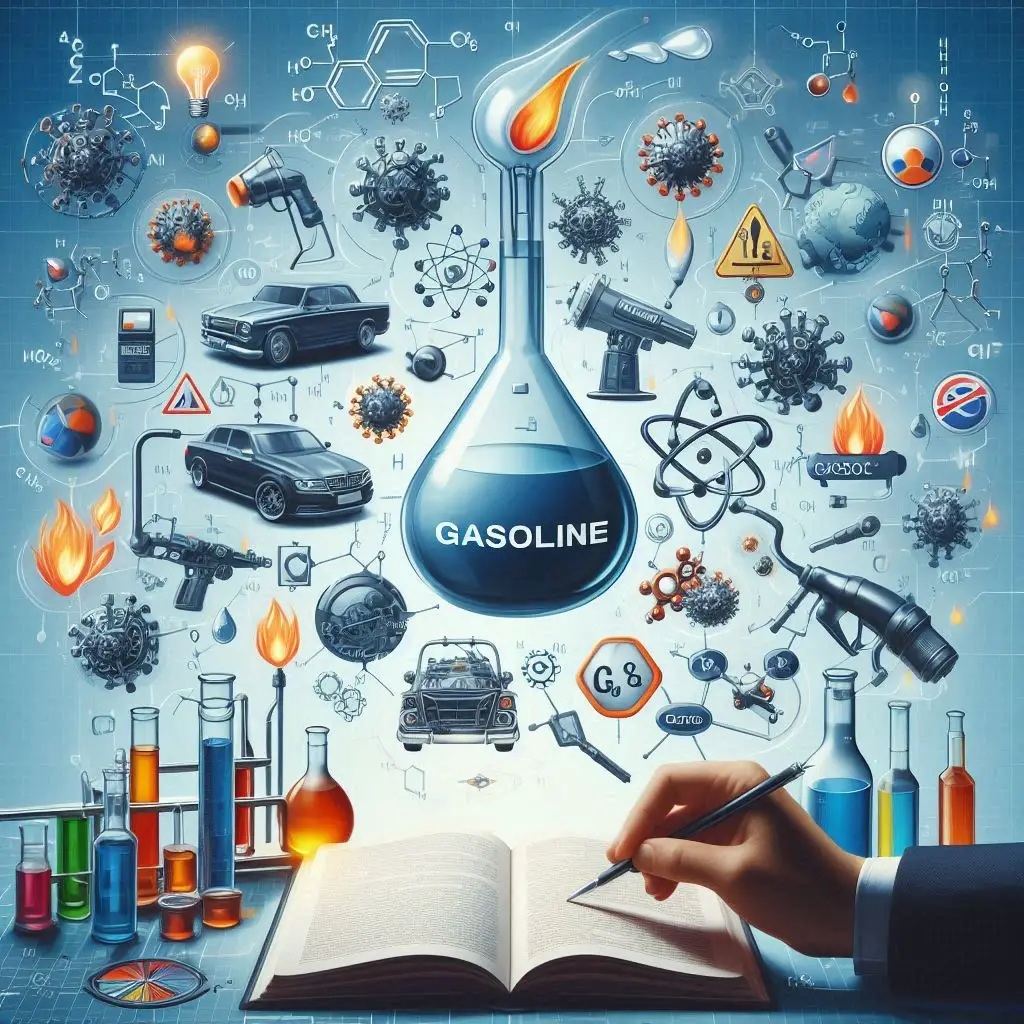
What is gasoline in chemistry
In this essay, what is gasoline in chemistry, we are going to conduct a comprehensive investigation of the chemistry of gasoline, including topics such as its make-up, production, combustion, influence on the environment, and potential for the future.
Gasoline is an essential hydrocarbon-based fuel that is produced via the refining process using crude oil as its starting material. Its chemical makeup is made up of a variety of hydrocarbons, such as alkanes, alkenes, aromatics, and cycloalkanes, in varying proportions. To produce gasoline with the attributes that consumers want, manufacturers must use procedures such as distillation, hydrodesulfurization, cracking, and blending.
The burning of gasoline in internal combustion engines provides the power necessary for transportation and the operation of machines; the byproducts of this process are carbon dioxide and water. However, its usage results in major environmental implications, including as increased air pollution and emissions of greenhouse gases, as well as negative impacts on human health.
Ongoing efforts are focused on discovering alternative fuels, increasing engine economy, and shifting to electric cars driven by cleaner energy sources in order to reduce the negative effects that these factors have on the environment. The chemistry behind gasoline and how it is used will continue to change as we progress toward a future that is more environmentally friendly. This change is necessary in order to strike a balance between meeting the energy demands of the globe and being responsible stewards of the environment.
Gasoline is a complex combination of hydrocarbons that is used as the principal fuel for internal combustion engines used in a variety of machines and vehicles, including cars and trucks. This multipurpose and ubiquitous fuel is essential to the operation of today's transportation systems, and it also plays an important part in our day-to-day life.
Overview of Gasoline
Petrol, commonly referred to as gasoline in many countries, is a fuel made mostly from hydrocarbons that is obtained by the refining of crude oil. Its blend of different hydrocarbons, which are substances made of hydrogen (H) and carbon (C) atoms, is what defines its chemical makeup. Based on their structure and bonding, these hydrocarbons are divided into many classes, such as alkanes, alkenes, and aromatics.
Ingredients in Gasoline
The composition of gasoline varies greatly and is influenced by a number of elements, including the crude oil source and the refining procedures used. Among the gasoline's principal ingredients are:
Alkanes: Saturated hydrocarbons having a single carbon-carbon bond are referred to as alkanes. They make up the largest group of chemicals in gasoline. Methane (CH4), ethane (C2H6), propane (C3H8), and butane (C4H10) are typical alkanes present in gasoline.
Alkenes: Alkenes are hydrocarbons that include at least one double bond between carbon atoms. Alkenes like ethylene and propene are often present in gasoline.
Aromatics: Another important component of gasoline is aromatic hydrocarbons, which comprise one or more benzene rings, hexagonal rings with six carbon atoms. Gasoline often contains the aromatic chemicals benzene, toluene, and xylene.
Cycloalkanes are cyclic hydrocarbons that only have one carbon-carbon link. One cycloalkane present in gasoline is cyclohexane.
Oxygenates: To increase combustion efficiency and lower emissions, oxygen-containing substances like alcohols (such as ethanol and methanol) and ethers (such as MTBE - methyl tert-butyl ether) may also be added to gasoline.
Additives: To improve performance and stability, gasoline may include a variety of additives, such as detergents, antioxidants, and anti-knock agents.
Making of Gasoline
Refining, a multi-step process used to separate crude oil into its many components depending on their respective boiling temperatures, is a necessary step in the manufacturing of gasoline. An outline of the refining procedure is given below:
Crude oil is heated in a distillation tower, where it vaporizes at various temperatures, throughout the distillation process. Condensed vapor from the process is then collected in trays at different tower heights. One of the fractions gathered in this process is gasoline.
Gasoline derived by distillation may include sulfur compounds, which are bad for the environment and engine parts. Hydrodesulfurization removes these compounds from the fuel. Gasoline is subjected to a procedure called hydrodesulfurization to purge it of sulfur contaminants.
Cracking: Processes like catalytic cracking or hydrocracking, which reduce bigger hydrocarbons into smaller ones, such as gasoline, are applied to heavier fractions from the distillation tower to maximize the production of gasoline.
Blending: To produce the necessary gasoline attributes, such as octane rating, volatility, and other performance characteristics, the different fractions and components acquired during refining are properly combined.
Fuel Burning in Gasoline
Internal combustion engines use the burning of gasoline as their primary fuel to power machines and vehicles. Carbon dioxide (CO2) and water (H2O) are the main byproducts of the combustion process that occurs when gasoline is burnt in the presence of oxygen:
Copy the second formula: C8H18 + 25 O2 16 CO2 + 18 H2O.
Exothermic means that a lot of energy is released in the form of heat during this combustion event. Engines use this energy to drive wheels or create electricity, among other mechanical tasks.
Gasoline's Effect on the Environment
Although gasoline is a necessary fuel for vehicles and other machines, its usage has several negative environmental effects:
Gasoline burning emits air pollutants such as carbon monoxide (CO), nitrogen oxides (NOx), and volatile organic compounds (VOCs), which help to create smog and deteriorate the quality of the air.
Gasoline burning is a substantial source of carbon dioxide (CO2) emissions, a key greenhouse gas that contributes to climate change and global warming.
Health Effects: Air pollutants that are hazardous to human health, such benzene and formaldehyde, are also present in gasoline emissions.
Oil spills may impact ecosystems and species during the extraction, transportation, and refinement of crude oil into gasoline.

